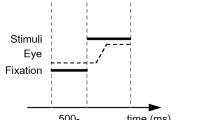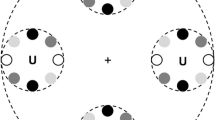Abstract
Interhemispheric transfer (IT) time through the corpus callosum can be measured with a manual reaction time (RT) to lateralized visual stimuli (the so-called Poffenberger paradigm) by subtracting mean RT of faster uncrossed hemifield-hand combinations (not requiring an IT) from slower crossed combinations (requiring an IT). That the corpus callosum is involved in IT has been demonstrated by its dramatic lengthening in patients with a section of the corpus callosum. However, it is still unclear whether the signal transmitted by the corpus callosum concerns perceptual or motor stages of RT. To try and cast light on this question, in a first experiment we tested normal subjects on a partially modified Poffenberger paradigm with stop trials intermingled with go trials. In the former, subjects are supposed to refrain from responding following a stop signal (stop-signal paradigm). This paradigm can tease apart the contribution of the controlled and ballistic stages to overall RT and, used together with the Poffenberger task, enables one to assess the stage at which IT occurs. The controlled stage lies before the point of no return, i.e. the point beyond which the response cannot be inhibited, and concerns perceptual and pre-motor processes, while the ballistic stage occurs after the point of no return and concerns the motoric aspect of the response. We found that the slower responses typically obtained in the crossed conditions were more likely to be inhibited than the faster uncrossed responses and this suggests that IT occurs prior to the point of no return. Since the precise locus of the point of no return is uncertain, in a second experiment we used response force as a dependent variable reflecting the activation of the motor cortex. We found that none of the force parameters studied differed between crossed and uncrossed conditions while the temporal parameters confirmed the presence of an advantage of the uncrossed combinations. Altogether these results suggest that callosal IT of visuomotor information occurs at the stage of controlled (perceptual and pre-motor) processes and rule out the possibility of an IT at the motoric stage.






Similar content being viewed by others
References
Aglioti S, Dall’Agnola R, Girelli M, Marzi CA (1991) Bilateral hemispheric control of foot distal movements: evidence from normal subjects. Cortex 27:571–581
Angel A (1973) Input-output relations in simple reaction time experiments. Q J Exp Psychol 25:193–200
Ashe J (1997) Force and the motor cortex. Behav Brain Res 87:255–269
Bashore TR (1981) Vocal and manual reaction time estimates of interhemispheric transmission time. Psychol Bull 89:352–368
Berlucchi G, Aglioti S, Marzi CA, Tassinari G (1995) Corpus callosum and simple visuomotor integration. Neuropsychologia 33:923–936
Carlton LG, Carlton MJ, Newell KM (1987) Reaction time and response dynamics. Q J Exp Psychol 39A:337–360
Cavina-Pratesi C, Bricolo E, Prior M, Marzi CA (2001) Redundancy gain in the stop-signal paradigm: implications for the locus of coactivation in simple reaction time. J Exp Psychol Hum Percept Perform 27:932–941
Chelazzi L, Marzi CA, Panozzo G, Pasqualini N, Tassinari G, Tomazzoli L (1988) Hemiretinal differences in speed of light detection in esotropic amblyopes. Vision Res 8:95–104
Cheney PD, Fetz EE (1980) Functional classes of primate cortico-motoneuronal cells and their relation to active force. J Neurophysiol 44:773–791
Clarke JM, Zaidel E (1989) Simple reaction times to lateralized light flashes. Varieties of interhemispheric communication routes. Brain 112:849–870
Colonius H (1990) A note on the stop-signal paradigm, or how to observe the unobservable. Psychol Rev 97:309–312
Colonius H, Ozyurt J, Arndt PA (2001) Countermanding saccades with auditory stop signals: testing the race model. Vision Res 41:1951–1968
Cramer SC, Weisskoff RM, Schaechter JD, Nelles G, Foley M, Finklestein SP, Rosen BR (2002) Motor cortex activation is related to force of squeezing. Hum Brain Mapp 16:197–205
Curcio CA, Sloan KR Jr, Packer O, Hendrickson AE, Kalina RE (1987) Distribution of cones in human and monkey retina: individual variability and radial asymmetry. Science 236:579–582
De Jong R, Coles MGH, Logan GD, Gratton G (1990) In search of the point of no return: the control of response processes. J Exp Psychol Hum Percept Perform 16:164–182
de Lacoste MC, Kirkpatrick JB, Ross ED (1985) Topography of the human corpus callosum. J Neuropathol Exp Neurol 44:578–591
Dettmers C, Fink GR, Lemon RN, Stephan KM, Passingham RE, Silbersweig D, Holmes A, Ridding MC, Brooks DJ, Frackowiak RS (1995) Relation between cerebral activity and force in the motor areas of the human brain. J Neurophysiol 74:802–815
Ehrsson HH, Fagergren A, Jonsson T, Westling G, Johansson RS, Forssberg H (2000) Cortical activity in precision- versus power-grip tasks: an fMRI study. J Neurophysiol 83:528–536
Evarts EV (1969) Activity of pyramidal tract neurons during postural fixation. J Neurophysiol 32:375–385
Franz EA, Miller J (2002) Effects of response readiness on reaction time and force output in people with Parkinson’s disease. Brain 125:1733–1750
Georgopoulos AP, Ashe J, Smyrnis N, Taira M (1992) The motor cortex and the coding of force. Science 256:1692–1695
Giray M, Ulrich R (1993) Motor coactivation revealed by response force in divided and focused attention. J Exp Psychol Hum Percept Perform 19:1278–1291
Iacoboni M, Zaidel E (1995) Channels of the corpus callosum. Evidence from simple reaction times to lateralized flashes in the normal and the split brain. Brain 118:779–788
Jaskowski P, Verleger R (1993) A clock paradigm to study the relationship between expectancy and response force. Percept Mot Skills 77:163–174
Jaskowski P, Rybarczyk K, Jaroszyk F, Lemanski D (1995) The effect of stimulus intensity on force output in simple reaction time task in humans. Acta Neurobiol Exp 55:57–64
Jennings JR, van der Molen MW, Brock K, Somsen RJM (1992) On the synchrony of stopping motor responses and delaying heartbeats. J Exp Psychol Hum Percept Perform 18:422–436
Konishi S, Nakajima K, Uchida I, Sekihara K, Miyashita Y (1998) No-Go dominant brain activity in human inferior prefrontal cortex revealed by functional magnetic resonance imaging. Eur J Neurosci 10:1209–1213
Konishi S, Nakajima K, Uchida I, Kikyo H, Kameyama M, Miyashita Y (1999) Common inhibitory mechanism in human inferior prefrontal cortex revealed by event-related functional MRI. Brain 122:981–991
Lappin JS, Eriksen CW (1966) Use of a delayed signal to stop a visual reaction time response. J Exp Psychol 72:805–811
Liddle PF, Kiehl KA, Smith AM (2001) Event-related fMRI study of Response Inhibition. Hum Brain Mapp 12:100–109
Logan GD (1994) On the ability to inhibit thought and action, a users’ guide to the stop signal paradigm. In: Dagenbach D, Carr TH (eds) Inhibitory processes in attention, memory and language. Academic Press, San Diego, CA, pp 189–239
Logan GD, Cowan WB (1984) On the ability to inhibit thought and action: a theory of an act of control. Psychol Rev 91:295–327
Logan GD, Cowan WB, Davis KA (1984) On the ability to inhibit simple and choice reaction time responses: a model and a method. J Exp Psychol Hum Percept Perform 10:276–291
Marzi CA (1999) The Poffenberger paradigm: a first, simple, behavioural tool to study interhemispheric transmission in humans. Brain Res Bull 50:421–422
Marzi CA, Bisiacchi P, Nicoletti R (1991) Is interhemispheric transfer of visuomotor information asymmetric? Evidence from a meta-analysis. Neuropsychologia 29:1163–1177
Marzi CA, Perani D, Tassinari G, Colleluori A, Maravita A, Miniussi C, Paulesu E, Scifo P, Fazio F (1999) Pathways of interhemispheric transfer in normals and in a split-brain subject. A positron emission tomography study. Exp Brain Res 126:451–458
Mattes S, Ulrich R (1997) Response force is sensitive to the temporal uncertainty of response stimuli. Percept Psychophys 59:1089–1097
Mattes S, Ulrich R, Miller J (2002) Response force in RT tasks: isolating effects of stimulus probability and response probability. Vis Cogn 9:477–501
McGarry T, Franks IM (1997) A horse race between independent processes: evidence for a phantom point of no return in the preparation of a speeded motor response. J Exp Psychol Hum Percept Perform 23:1533–1542
Miller J, Franz V, Ulrich R (1999) Effects of auditory stimulus intensity on response force in simple, go/no-go, and choice RT tasks. Percept Psychophys 61:107–119
Milner AD, Lines CR (1982) Interhemispheric pathways in simple reaction time to lateralized light flash. Neuropsychologia 20:171–179
Mordkoff JT, Miller J, Roch AC (1996) Absence of coactivation in the motor component: evidence from psychophysiological measures of target detection. J Exp Psychol Hum Percept Perform 22:25–41
Osman A, Kornblum S, Meyer DE (1986) The point of no return in choice reaction time: controlled and ballistic stage of response preparation. J Exp Psychol Hum Percept Perform 12:243–258
Osman A, Kornblum S, Meyer DE (1990) Does motor programming necessitate response execution? J Exp Psychol Hum Percept Perform 16:183–198
Osterberg G (1935) Topography of the layer of rods and cones in the human retina. Acta Ophthalmol Suppl 61:1–102
Peck KK, Sunderland A, Peters AM, Butterworth S, Clark P, Gowland PA (2001) Cerebral activation during a simple force production task: changes in the time course of the haemodynamic response. Neuroreport 12:2813–2816
Poffenberger AT (1912) Reaction time to retinal stimulation with special reference to the time lost in conduction through nervous centres. Arch Psychol 23:1–73
Rains JD (1962) Signal luminance and position effects in human reaction time. Vision Res 3:239–251
Ratcliff R (1979) Group reaction time distributions and an analysis of distribution statistics. Psychol Bull 86:446–461
Ratinckx E, Brysbaert M, Vermeulen E (2001) CRT screens may give rise to biased estimates of interhemispheric transmission time in the Poffenberger paradigm. Exp Brain Res 136:413–416
Rubia K, Russell T, Overmeyer S, Brammer MJ, Bullmore ET, Sharma T, Simmons A, Williams SCR, Giampietro V, Andrew CM, Taylor E (2001) Mapping motor inhibition: conjunctive brain activations across different version of Go/No-Go and Stop tasks. Neuroimage 13:250–261
Stancak A Jr, Luecking CH, Kristeva-Feige R (2000) Lateralization of movement-related potentials and the size of the corpus callosum. Neuroreport 11:329–332
Tettamanti M, Paulesu E, Scifo P, Maravita A, Fazio F, Perani D, Marzi CA (2002) Interhemispheric transmission of visuomotor information in humans: fMRI evidence. J Neurophysiol 88:1051–1058
Thickbroom GW, Phillips BA, Morris I, Byrnes ML, Mastaglia FL (1998) Isometric force-related activity in sensorimotor cortex measured with functional MRI. Exp Brain Res 121:59–64
Ulrich R, Wing AM (1991) A recruitment theory of force-time relations in the production of brief force pulses: the parallel force unit model. Psychol Rev 98:268–294
Ulrich R, Rinkenauer G, Miller J (1998) Effects of stimulus duration and intensity on simple reaction time and response force. J Exp Psychol Hum Percept Perform 24:915–928
Ulrich R, Mattes S, Miller J (1999) Donder’s assumption of pure insertion: an evaluation on the basis of response dynamics. Acta Psych 102:43–75
Acknowledgements
This research was supported by COFIN MURST to C.A.M. The technical assistance of Gianni Finizia and Daniele Molinari and the comments of two anonymous referees are gratefully acknowledged.
Author information
Authors and Affiliations
Corresponding author
Rights and permissions
About this article
Cite this article
Cavina-Pratesi, C., Bricolo, E., Pellegrini, B. et al. At what stage of manual visual reaction time does interhemispheric transmission occur: controlled or ballistic?. Exp Brain Res 155, 220–230 (2004). https://doi.org/10.1007/s00221-003-1712-1
Received:
Accepted:
Published:
Issue Date:
DOI: https://doi.org/10.1007/s00221-003-1712-1




